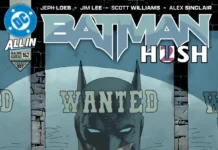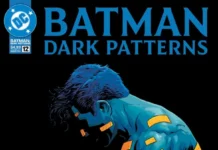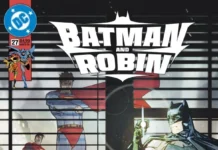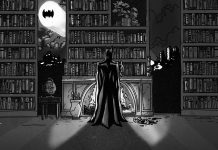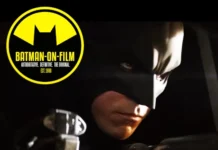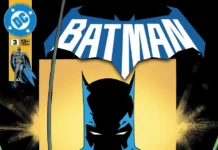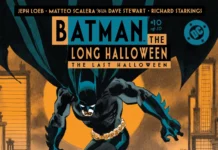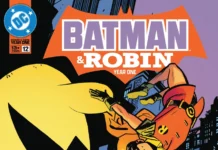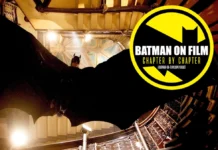I’m writing this on March 30th, 2014. Today marks the officially recognized 75th anniversary of the first appearance of The Dark Knight himself, and to mark the occasion, Mr. Bill “Jett” Ramey has asked me to compile a list of the most important Batman comic book stories from the period of 1990-2009. This is already no easy task, but to know that it’s coming off of the handpicked selections from the 1940s-80s of the incomparable Michael Uslan, kind of makes this akin to following the King of Rock n’ Roll himself!
Still, though, the era that Jett has assigned to me is my Batman. The Batman that saw a massive popularity spike due to the films of Tim Burton, the Batman that was both active during, and inspired by the work of Paul Dini and Bruce Timm on Batman: The Animated Series, and the era that would help define the narrative aims of perhaps the best superhero films ever released under the guiding hand of Christopher Nolan.
I think I know a thing or two about this Batman. So, in honor of his 75th birthday, here are my top 10 selections of comic book story arcs from the era of 1990-2009.
10) Batman: War Games by Ed Brubaker, Greg Rucka, Bill Willingham, Devin Grayson, Pete Woods, Sean Phillips, and others
Perhaps one of the most defining Batman stories of the 1980s was “Death in the Family”, since it told the story of what happens to Batman when a loss hits very close to home.
 War Games was a Batman-centric event that took that idea a step further, since the loss endured by the end of that story came about because of one of the ideas in Batman’s library of contingency plans against the Gotham underworld. Stephanie Brown, who was serving as Robin at the time, stumbled upon a plan that would seek to control a rampant outbreak of gang violence by uniting the entirety of Gotham’s criminal underworld under one crime boss: Matches Malone. What Stephanie didn’t realize when she saw this plan was that Matches was not an employee, but an alias of The Batman himself. Stephanie is fired by Batman for an unrelated reason, and seeks to enact this plan to get back into his good graces.
War Games was a Batman-centric event that took that idea a step further, since the loss endured by the end of that story came about because of one of the ideas in Batman’s library of contingency plans against the Gotham underworld. Stephanie Brown, who was serving as Robin at the time, stumbled upon a plan that would seek to control a rampant outbreak of gang violence by uniting the entirety of Gotham’s criminal underworld under one crime boss: Matches Malone. What Stephanie didn’t realize when she saw this plan was that Matches was not an employee, but an alias of The Batman himself. Stephanie is fired by Batman for an unrelated reason, and seeks to enact this plan to get back into his good graces.
It goes without saying that all hell quickly breaks loose on the city streets.
It’s a very interesting crime-centric story by some of comics’ best writers and artists, with Batman and his allies struggling to pick up the pieces from the plan gone completely wrong. In the end, it cost the former Robin her life (at least it looked that way thanks to a later retcon), and also set the stage for the next year of stories in which the Gotham underworld is led by Black Mask. All in all, this is a great story for the era, and one of the more engaging comic book events of the 2000s.
9) Bruce Wayne: Murderer/Fugitive by Ed Brubaker, Greg Rucka, Scott McDaniel, and others
 There’s something that still proves to be fundamentally intriguing about a story that definitively places Bruce Wayne on the wrong side of the law, especially while Batman’s name remains relatively untarnished. When Bruce Wayne is arrested for the murder of Vesper Fairchild, it starts an in-depth murder mystery that hits Batman and his allies very hard. Of course, Batman would never let anyone know that he would be at all affected, so when the quest to clear his name ends up progressing very poorly, one of his most immediate solutions is to “retire” his Bruce Wayne persona – permanently.
There’s something that still proves to be fundamentally intriguing about a story that definitively places Bruce Wayne on the wrong side of the law, especially while Batman’s name remains relatively untarnished. When Bruce Wayne is arrested for the murder of Vesper Fairchild, it starts an in-depth murder mystery that hits Batman and his allies very hard. Of course, Batman would never let anyone know that he would be at all affected, so when the quest to clear his name ends up progressing very poorly, one of his most immediate solutions is to “retire” his Bruce Wayne persona – permanently.
The rest of the plot is explored in a frenzying whirlwind of events, ultimately leading to the true murderer of Wayne’s former lover, and the extremely powerful DC Universe character that ultimately orchestrated the entire affair as a definitive stroke of revenge against Bruce Wayne. The entire event shows off some of the best Batman storytelling of this entire selected era, and still stands up as an excellent statement not just for Batman, but for the people he chooses to associate with, as well as the villains who oppose him.
8) Batman: Under the Hood by Judd Winick and Doug Mahnke
 Undoubtedly one of the more controversial Batman stories from this era, Under the Hood had the audacity to undo one of the most defining deaths of the modern, post-Crisis Batman! At least, that may have been the immediate knee-jerk reaction among some fans. What Judd Winick actually did was literally bring one of Batman’s greatest failures back to haunt him. One of the most efficient ways to accomplish this was by taking one of the young people he mentored, and turn him loose on the unsuspecting criminal population of Gotham. By itself this wouldn’t necessarily be much of a problem, except for the fact that Jason Todd now resented Batman, and was no longer “shackled” to his former mentor’s sense of morality or respect for life. The new Red Hood was a killer, and a vicious one at that.
Undoubtedly one of the more controversial Batman stories from this era, Under the Hood had the audacity to undo one of the most defining deaths of the modern, post-Crisis Batman! At least, that may have been the immediate knee-jerk reaction among some fans. What Judd Winick actually did was literally bring one of Batman’s greatest failures back to haunt him. One of the most efficient ways to accomplish this was by taking one of the young people he mentored, and turn him loose on the unsuspecting criminal population of Gotham. By itself this wouldn’t necessarily be much of a problem, except for the fact that Jason Todd now resented Batman, and was no longer “shackled” to his former mentor’s sense of morality or respect for life. The new Red Hood was a killer, and a vicious one at that.
The closing moments of the story also help provide a creatively derivative rededication to Batman’s “one rule.” Batman fans have read and seen this explanation before, but it manages to strike a uniquely personal chord when he’s faced off against the former Robin, with the Joker of all people caught in the middle. The story was also the basis for one of the better DC Universe Animated Original Films, and easily stands on its own as a reintroduction to the new conception of Jason Todd, as well as a forward-thinking story that answered some of the most lingering questions for the character from the previous two decades.
7) Whatever Happened to the Caped Crusader? By Neil Gaiman and Andy Kubert
 Told in a similarly ethereal style to Alan Moore’s Superman paean “Whatever Happened to the Man of Tomorrow?”, this Caped Crusader counterpart was written by one of the most enigmatic and critically-acclaimed writers in the history of the industry.
Told in a similarly ethereal style to Alan Moore’s Superman paean “Whatever Happened to the Man of Tomorrow?”, this Caped Crusader counterpart was written by one of the most enigmatic and critically-acclaimed writers in the history of the industry.
Batman is dying, and in those final moments of life that he has left, he’s living out several possible ways of how his story could be brought to an end. All of these disparate tales are woven together by a common locale: his funeral, where a continually morphing corpse in the casket represents various eras of the hero’s history.
The end of the story is one of the most poetic and interesting justifications for Batman’s mission ever published. Within the story’s pages, he flat-out says that he doesn’t believe in an afterlife. He doesn’t believe that there’s somewhere you go for being good or bad when it’s all said and done. And, in that moment, an apparition of one of the ultimate architects of Batman’s mission tells him that he gets no reward waiting for him: his reward for being Batman was being Batman: a reward shared by anyone who was touched by his influence in their lives.
6) Dark Moon Rising by Matt Wagner
 One of the most fun time frames to explore in Batman’s history during the post-Crisis, pre-New 52 era was within the first couple of years of his war on crime. Frank Miller’s Year One story from 1987 helped define the beginning of Batman’s career in the modern era, but when great creators who love the character’s whole history come along to reimagine some of those early Kane/Finger era stories for the modern age, sometimes magic can happen. This is one of those instances.
One of the most fun time frames to explore in Batman’s history during the post-Crisis, pre-New 52 era was within the first couple of years of his war on crime. Frank Miller’s Year One story from 1987 helped define the beginning of Batman’s career in the modern era, but when great creators who love the character’s whole history come along to reimagine some of those early Kane/Finger era stories for the modern age, sometimes magic can happen. This is one of those instances.
Dark Moon Rising consists of two miniseries by writer/artist Matt Wagner. Batman and the Monster Men features Hugo Strange as the primary villain, while Batman and the Mad Monk features a vampiric villain with ties to the Golden Age. Because these stories take place after Year One but before Batman’s first 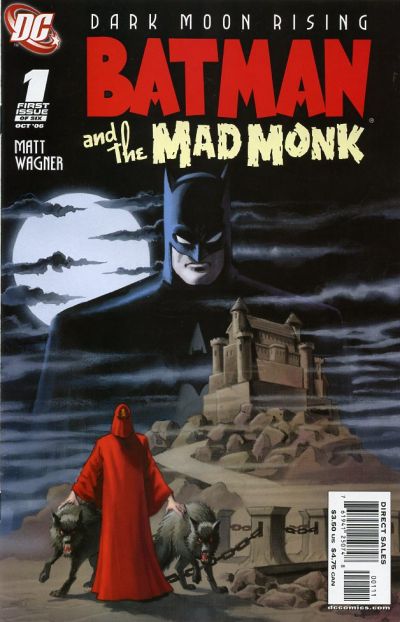 encounter with The Joker, it’s meant to depict his first encounter with “super crime.”
encounter with The Joker, it’s meant to depict his first encounter with “super crime.”
Year One is a definitive Batman story on many levels, but the enemies Batman fights there are largely within his comfort zone, or at least what he prepared to take on during his time abroad. Dark Moon Rising confronts him with a kind of evil he didn’t prepare for, and since the DC Universe-at-large is populated by anything from Kryptonians to magic-wielders, it makes sense to show how Batman tries to take on this special kind of evil. In the hands of a lesser creator, these stories could’ve been gimmicky and predictable, but Wagner helped make them truly definitive tales for the ground-level vigilante people have come to know and love.
5) Batman: Hush by Jeph Loeb and Jim Lee
 Sometimes, a comic book story can come along that can help define a character’s aesthetic for years to come. When Hush was released with great hype and anticipation, this is one of the ways that it has managed to make an indelible impression on many of the comic book stories that followed, from the Batsuit to the shadows. It was also not out of the ordinary for a lot of non-comic book Batman products like T-shirts, posters, mugs, etc. to feature artwork directly from Hush. But beyond all of that, the story was popular and largely well-received simply because of its massive scale.
Sometimes, a comic book story can come along that can help define a character’s aesthetic for years to come. When Hush was released with great hype and anticipation, this is one of the ways that it has managed to make an indelible impression on many of the comic book stories that followed, from the Batsuit to the shadows. It was also not out of the ordinary for a lot of non-comic book Batman products like T-shirts, posters, mugs, etc. to feature artwork directly from Hush. But beyond all of that, the story was popular and largely well-received simply because of its massive scale.
Writer Jeph Loeb managed to use his previous experience with the Batman character to craft a story that spanned almost all of the major players of the storied rogues’ gallery, and even into some of his more established associations within the DC Universe itself. Batman even said of the plot in the story: “It reaches as high as Superman…and as low as The Joker.”
For all the beloved solo and more personal or intimate Batman stories, every once in a while we get a Transformers-esque “blockbuster,” which has equal potential to blow up in someone’s face, or pull off some good comic book storytelling. Largely, Hush manages to reach some pretty great heights, made endlessly interesting on a first read-through for the rollercoaster ride it gives the Dark Knight.
4) Batman R.I.P. by Grant Morrison and Tony Daniel
 I know all too well that while Grant Morrison was the driver behind the wheel of the Batman franchise at DC Comics, it turned more than a few people off. Now that a couple of years have passed between his more radical changes, though, it’s easier for many to see that his entire long-form narrative was, perhaps, the biggest love letter to Batman that has ever been written. Yes, things got a little odd, and yes, it was very dense. The heart of the run is exemplified by R.I.P., though, because of what it did so masterfully: what looked at the beginning like a deconstruction ended up being a massive celebration for the entirety of the character’s existence.
I know all too well that while Grant Morrison was the driver behind the wheel of the Batman franchise at DC Comics, it turned more than a few people off. Now that a couple of years have passed between his more radical changes, though, it’s easier for many to see that his entire long-form narrative was, perhaps, the biggest love letter to Batman that has ever been written. Yes, things got a little odd, and yes, it was very dense. The heart of the run is exemplified by R.I.P., though, because of what it did so masterfully: what looked at the beginning like a deconstruction ended up being a massive celebration for the entirety of the character’s existence.
Morrison’s main theory driving his run on the Batman titles was that everything in Batman’s publication history had happened in some way, shape, or form. He didn’t care that a Crisis or two came along to sweep some continuity under the rug, he was telling us that everything in the pages of Batman comics from the last three-quarters of a century were actually the adventures of one extraordinary man’s vivid and exceptional life. When the culmination of that life comes down on him, he finds a way to show us that beating the odds can be very hard, “but far from impossible.” Sounds like a great sentiment to have for both inspiration, and as a statement for what Batman is all about.
3) Knightfall by Chuck Dixon, Denny O’Neil, Doug Moench, Jim Aparo, and Graham Nolan, and others
 The early 1990s was a generally rough era for the comic book industry, which extended to both the major publishers as well as to independents. Gimmicks were being exhausted on the page (*cough*Clone Saga! *cough*) and off the page (chromium variant covers, anyone?), sales were progressively declining when the speculator market bottomed out (which is why that Claremont/Lee X-Men #1 didn’t put your child through college), and the stories in general had hit something of a lull. The era wasn’t without its memorable contributions, though, and one of those is undoubtedly the story that “broke the Bat:” Knightfall.
The early 1990s was a generally rough era for the comic book industry, which extended to both the major publishers as well as to independents. Gimmicks were being exhausted on the page (*cough*Clone Saga! *cough*) and off the page (chromium variant covers, anyone?), sales were progressively declining when the speculator market bottomed out (which is why that Claremont/Lee X-Men #1 didn’t put your child through college), and the stories in general had hit something of a lull. The era wasn’t without its memorable contributions, though, and one of those is undoubtedly the story that “broke the Bat:” Knightfall.
Knightfall is actually pretty unique in the pantheon of post-Crisis Batman stories, since the villain that it featured, Bane, managed not only to break in to Batman’s top tier of antagonists, but largely stay there in the intervening years since. Of the handful of Batman villains adapted to his feature film adventures, Bane is one of them, which on its own is a pretty astounding feat. Beyond the historical significance, though, lie the tenets of an exciting and suspenseful Batman tale that breaks down much of the character’s infrastructure – figuratively and literally – while eventually giving rather literal service to a continuous piece of Batman’s constitution: throw everything you can at him, he’ll still find a way to come back and be even better than he was before.
2) No Man’s Land by Chuck Dixon, Greg Rucka, Scott Beatty, Greg Land, Dale Eaglesham, Alex Maleev, and others
 With a character like Batman, who’s been in continuous publication for 75 years, creators can be somewhat limited even when trying to tell a new story. Largely, you have to work within the same kinds of constraints and requirements in the modern era as the creative teams in the 1980s did, and for some, it can be stifling. For creators that have the intestinal and creative fortitude to come up with entirely new situations while still holding true to the things that make the involved characters great is a miraculously difficult challenge. Going into a Batman story, you know a few things right from the start: Batman’s probably not going to die, he probably won’t kill his villain, and Gotham City will probably still be standing when it’s all said and done. No Man’s Landtook that last thing, and threw it out the window.
With a character like Batman, who’s been in continuous publication for 75 years, creators can be somewhat limited even when trying to tell a new story. Largely, you have to work within the same kinds of constraints and requirements in the modern era as the creative teams in the 1980s did, and for some, it can be stifling. For creators that have the intestinal and creative fortitude to come up with entirely new situations while still holding true to the things that make the involved characters great is a miraculously difficult challenge. Going into a Batman story, you know a few things right from the start: Batman’s probably not going to die, he probably won’t kill his villain, and Gotham City will probably still be standing when it’s all said and done. No Man’s Landtook that last thing, and threw it out the window.
In the Cataclysm arc, Gotham was ravaged by a massive earthquake. No Man’s Land is the event where the allies and enemies of Batman alike were left trying to pick up the literal and proverbial pieces of what was left of Gotham, and try to bring some order to the chaos. In the story, when Gotham was hit by the Earthquake, the United States Congress declared it a federal “No Man’s Land,” since the cost of rebuilding the city was too much for the American taxpayers. Even a personal appeal by Bruce Wayne himself couldn’t sway the decision, so eventually, after the bridges into the city were destroyed, the Dark Knight journeyed back into the city he loves and tried to create order on the damaged streets.
It was a long arc, featuring cool guest stars (I have a particular soft spot for Superman’s appearance in Batman #566), and culminated in a definitive, yet heartbreaking and continuously satisfying encounter between Batman, The Joker, and Jim Gordon. All in all, while pretty long, No Man’s Land is a general highlight of 1990’s Batman comics. If you don’t exactly want to invest in a whopping five trade paperbacks, though, Greg Rucka’s novelization is an excellent and efficient way to read the story.
1) The Long Halloween/Dark Victory by Jeph Loeb and Tim Sale
 Although these are two different stories, both are heavily connected by continuity and thematic aim and are largely best if read together. For the purposes of this list, if split apart then I would have still included both, so I figured it would be best to consolidate them into one position, since the greatness of both definitely earns the top spot here in my view.
Although these are two different stories, both are heavily connected by continuity and thematic aim and are largely best if read together. For the purposes of this list, if split apart then I would have still included both, so I figured it would be best to consolidate them into one position, since the greatness of both definitely earns the top spot here in my view.
These stories are the crowning jewels of late 1990’s/2000 Batman for a few reasons. One of the most predominant ones is that it directly continued from the history established in Frank Miller’s Year One a decade earlier, giving a definitive account of the second and third years of Batman’s crusade, in addition to giving perhaps the best takes on the origins of several important characters. One of the most rewarding aspects of reading these tales, especially together, is in looking at the evolution of Gotham City itself: The definitive and stylistic artwork of Tim Sale helps give “early Gotham” a very appropriate noir-like quality, something more akin to San Francisco in John Huston’s The Maltese Falconthan a booming 1990s metropolis.
 From there, we get a firsthand account from the very characters that shape Gotham on how it evolves from being under the control of organized crime families, and transitions into control by “the freaks,” like the Joker or the Penguin. Anchoring all of this through Long Halloween is the tragic fall from grace of crusading D.A. Harvey Dent, giving the story a tragic but necessary end.
From there, we get a firsthand account from the very characters that shape Gotham on how it evolves from being under the control of organized crime families, and transitions into control by “the freaks,” like the Joker or the Penguin. Anchoring all of this through Long Halloween is the tragic fall from grace of crusading D.A. Harvey Dent, giving the story a tragic but necessary end.
Picking up the pieces right away is Dark Victory, continuing many of the thematic threads, but also introducing an entirely new one: hope, represented by a highly skilled and bright young boy. Part of what makes Dark Victory so compelling is the fact that it uses a defining tragedy in Batman’s early career, the creation of Two-Face, as a springboard into, arguably, one of his greatest triumphs: Dick Grayson. As a modern origin story for the Boy Wonder, Dark Victory helps end the whole saga of Batman’s second and third year on a hopeful note of both destiny and possibility, especially for an era in which the “modern Batman’s” primary Robin had only been either Jason Todd or Tim Drake (Dick graduated to the position of Nightwing before the first Crisis).
This is without mentioning, of course, the extreme importance both of these stories had in helping shape the structure of Christopher Nolan’s latter two efforts with Batman on film. For batman in comics, it doesn’t get much better, which is why these stories collectively demand the top spot in this particular list.
So that’s it! It was an extraordinary task trying to narrow down and sort this list, but I’m grateful to Jett for the opportunity to celebrate the character that we all love, and that helped create this great community. Special thanks goes out to anyone who threw their suggestions to me over the course of writing this piece, as well as Chris of Arkhamverse.com for another brain to bounce a few ideas off of.
And again, the beauty of Batman is that he’s universal: this may not be your list, but yours is just as valid as anyone else’s. Happy Birthday, Batman. Here’s to 75 more! – Chris Clow

